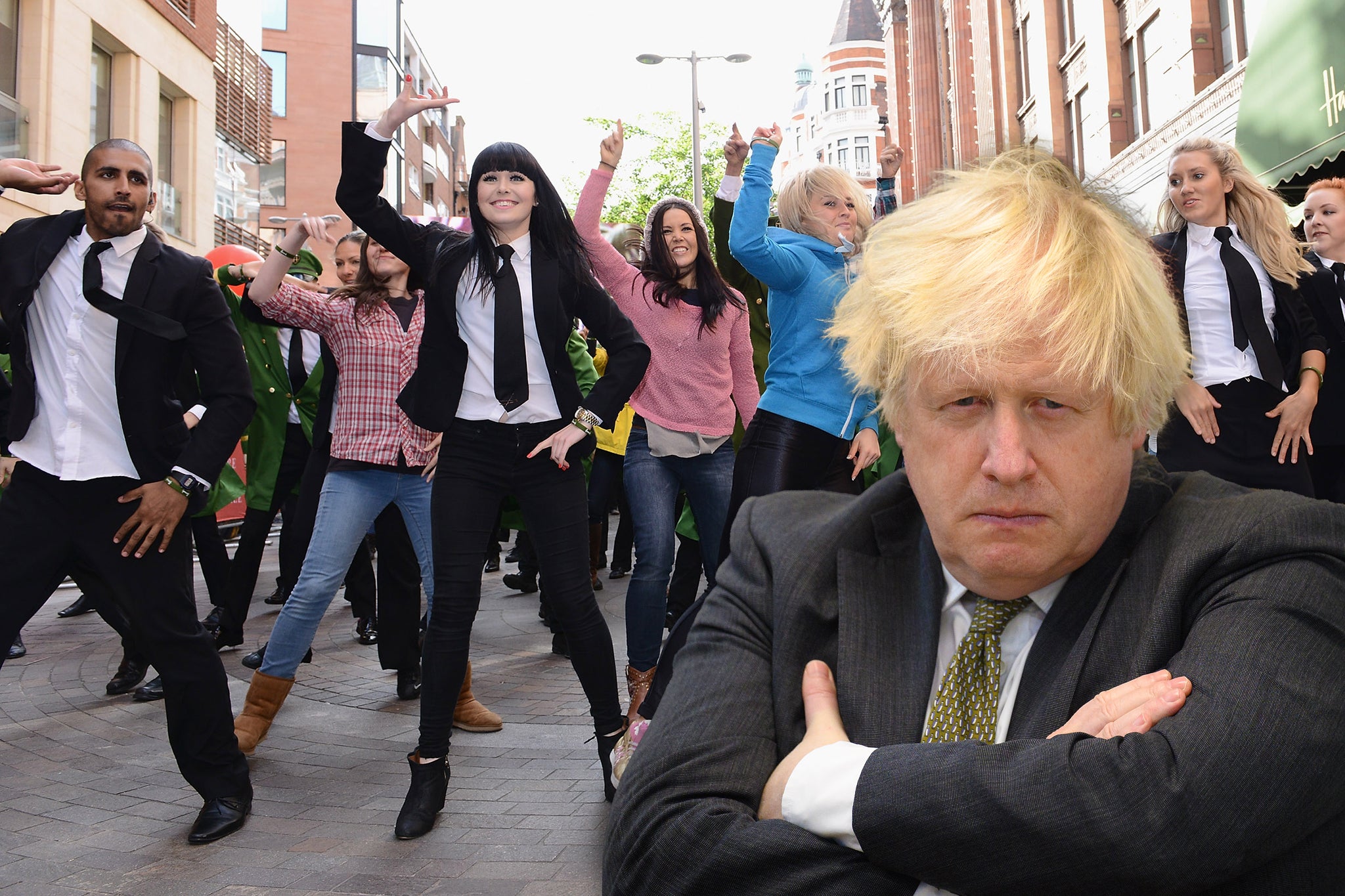Cringe didn’t kill off the flash mob – Boris Johnson did
The sight of throngs of people coming together in public to dance or freeze or do something silly was once ubiquitous, if always soundtracked by snide remarks about their pointlessness. But Oliver Keens is eager for their return, particularly because he blames the former PM for sounding their death knell


Your support helps us to tell the story
From reproductive rights to climate change to Big Tech, The Independent is on the ground when the story is developing. Whether it's investigating the financials of Elon Musk's pro-Trump PAC or producing our latest documentary, 'The A Word', which shines a light on the American women fighting for reproductive rights, we know how important it is to parse out the facts from the messaging.
At such a critical moment in US history, we need reporters on the ground. Your donation allows us to keep sending journalists to speak to both sides of the story.
The Independent is trusted by Americans across the entire political spectrum. And unlike many other quality news outlets, we choose not to lock Americans out of our reporting and analysis with paywalls. We believe quality journalism should be available to everyone, paid for by those who can afford it.
Your support makes all the difference.It’s 16 years this week since alcohol was banned on the London Underground. This is an impressively pointless ban, that absolutely nobody obeys, but that’s not why the date is etched on my mind. Nor is it because of the great statesman who implemented it. It’s because it inadvertently killed off one of the last great ways to be absurd in British life: the flash mob.
It began when Boris Johnson – mostly known until then as a buffoonish Tory MP and much-chortled-at host of Have I Got News For You – unexpectedly won the election to become London’s mayor. Among his pledges was a slightly trivial ban on people drinking on the Tube. It angered the unions but, more fatefully, it angered cheeky students on Facebook, who soon organised groups such as “Last Round on the Underground”.
“We need to make this big,” stated one group. “Spread the word and we’ll flash mob the Tube,” read another. Media picked up on plans for a cocktail party on the Circle Line and the whole thing went out of control. Around 2,000 people turned up. Some brought sound systems. Many brought inflatables. Chants of “Boris is a w*****” echoed on platforms. People drank and drank and sometimes fought while being packed into carriages. By the end there was more sick flowing than the series ending of The Inbetweeners. While most people still saw it as light-hearted fun, the headlines the next morning talked of it like a riot. It was the final nail in the coffin for the flash mob.
Flash mobs were never intended to be political. They were meant to be like an episode of Seinfeld: about “nothing”. The 2000s weren’t an apolitical era – millions around the world had marched five years previously against the Iraq war – but the concept of a flash mob was deliberately surreal and silly. Generally acknowledged to have first occurred in New York in 2003, when scores of people turned up at Macy’s department store to collectively try to buy a rug, they were meant to be strange, unexplained phenomena – people spontaneously applauding in a hotel, or standing frozen in Grand Central Station – that occurred before things rapidly went back to normal. Crucially they weren’t badged or labelled when they happened, and in an age before “going viral” was a goal, they were mostly undocumented and unattributed. They just... happened.
Unlike Sixties notions of a marauding counter-culture “freaking out the squares”, there was no overarching target of a flash mob. They were curiosities, not confrontations. But the fact that people met up to do things like imitate birdsong or dance to Metallica via a still-developing internet culture led many to assume they were a profound statement of the era. But I was there, and they absolutely weren’t. They were just silly. I marched against the Iraq war but also dressed as Santa for a flash mob. One didn’t negate the other.
People looked for a deeper significance, and when they couldn’t find one, they sneered. Boy did they sneer. Flash mobs, with their emphasis on simple joy and unfashionable silliness, seemed precision engineered to annoy Vice in particular, a magazine that at the time revelled in keeping young people in an anxious chokehold of worrying if something was good because it was ironic, or good because it was just – y’know – good. Amazingly, a post still online from 2010 opens with the pejorative line: “Flash mobs are the gayest thing ever.” Mainstream media was just as snide. The New York Times’s first article on flash mobs was curtly headlined: “Guess Some People Don’t Have Anything Better To Do.”
Yet it’s daft to look at flash mobs as synonymous with internet culture today because that phase of online life is well and truly gone. Flash mobs reflected a time when the internet was still seen as an exciting way of connecting random people and coalescing them around random things. Today, if 200 people walked into a rug store, they would all undoubtedly be selfie-ing themselves in the moment, creating 200 individual bits of narcissistic content and confusing nobody around them in the process. Ask the internet about flash mobs today and ironically it only serves up the worst aspects – the cynical marketing events, the gross marriage proposals, the mawkish mass singalongs that inadvertently paved the way for Glee.

But truthfully, flash mobs feel far less connected to the culture of the internet and more aligned to a much richer and almost ancient culture: the culture of doing totally stupid things because they make us feel good.
British people have done a lot of odd things in the past in the name of leisure. Take gurning, a rural English tradition of making a contorted face and showing it off to your approving peers. Then there’s Morris dancing, all charmingly dressed up as a worthy folk tradition but also knowingly ridiculous for participants at the same time. Cheese rolling and welly wanging – throwing a wet wellington boot as far as you can – are all things that have existed for decades without hipsters wondering if they’re fun in an ironic way. The same goes for gravy wrestling, which annually takes place in Lancashire. It’s not just in the UK where a sense of absurdist pursuit exists: there’s the Finnish act of getting “pantsdrunk”, for example, or the Spanish tradition of “La Tomatina”, an event that brilliantly has zero cultural significance or meaning whatsoever. It’s literally just chucking loads of tomatoes at each other.
Modern life is hard, and the act of protesting – against successive Tory home secretaries, for example – should never be trivialised. Yet for all its flaws, the flash mob offered a brief avenue for ordinary people to come out of themselves, submit to a group activity no matter how inane, and shake off external cynicism to engage in a non-toxic form of ridiculous, congregational fun. I’d definitely raise a glass to their return, one day – even on the Tube (really, nobody’s going to mind).
Join our commenting forum
Join thought-provoking conversations, follow other Independent readers and see their replies
Comments